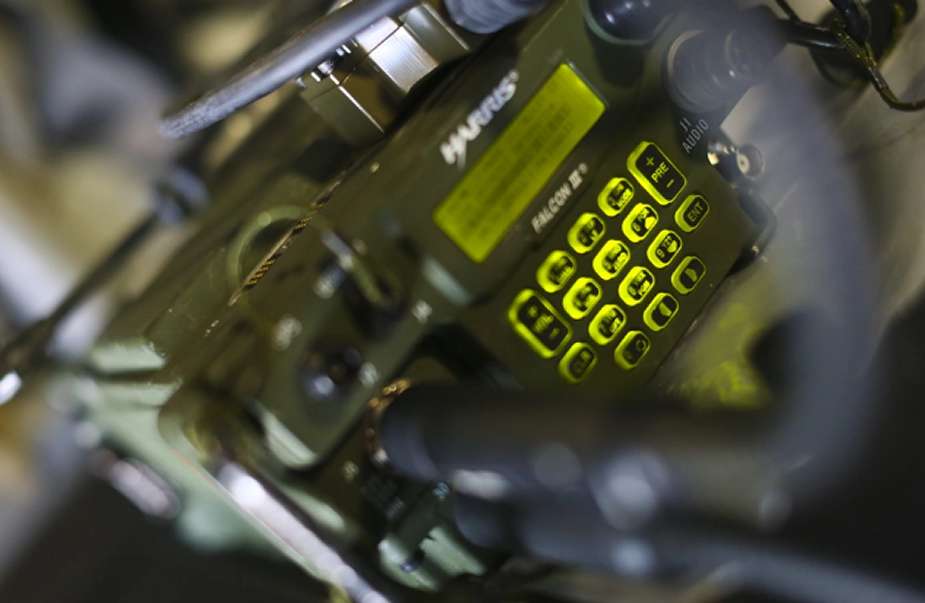US Marine Corps' new radios cement electromagnetic spectrum superiority
In a decisive step aimed at securing dominance in the electromagnetic spectrum, the Marine Corps Systems Command is making progress in upgrading 50,000 outdated radios with cutting-edge multi-channel, crypto-compliant models in Fiscal Year 2024, as reported by Johannes Schmidt from the Office of Public Affairs and Communication at MARCORSYSCOM Marine Corps Systems Command.
Follow Army Recognition on Google News at this link

An AN/PRC-117G Adaptive Networking Wideband Waveform operates during a communications set up practical application on an MV-22 Osprey aboard Marine Corps Air Station Yuma, Ariz., on March 23, 2016 (Picture source: USMC/Cpl. Summer S. Dowding, MAWTS-1 COMCAM)
An AN/PRC-117G Adaptive Networking Wideband Waveform operates during a communications set up practical application on an MV-22 Osprey aboard Marine Corps Air Station Yuma, Ariz., on March 23, 2016 Aligned with the Force Design's call for rapid force modernization, the Program Manager for Communications Systems (PM CS) team within MARCORSYSCOM has been swift in their actions, already deploying more than 4,000 radios across the fleet since October 2023.
In recent times, experts have cautioned about the stagnation in U.S. electromagnetic spectrum operations, which involves the strategic and tactical management of electromagnetic frequencies for military purposes such as communications, intelligence, and combat operations. This stagnation has allowed adversaries to challenge American supremacy in this crucial domain.
Recognizing the urgent need for change, the 2018 National Defense Strategy laid the groundwork for the Department of Defense's 2020 Electromagnetic Spectrum (EMS) Superiority Strategy. This document underscores the EMS as a critical battleground where invisible waves and frequencies play a pivotal role in modern warfare.
With this new strategic perspective, PM CS has been diligently working to update the fleet's radio capabilities, ensuring that they possess the necessary communication tools to succeed, regardless of the environmental and electromagnetic conditions they encounter. Richard Sessions, the program manager for Communications Systems, stated, "We started deployment in October, focusing on specific domains while ensuring that the radios meet cryptographic compliance standards mandated by the NSA. This compliance enables secure operations across various frequencies and in secure environments. Our deadline for achieving this compliance is set for December 31, 2024."
The new multi-channel radios offer a versatile, software-defined system that emphasizes modularity and flexibility, allowing for the rapid integration of new waveforms and cryptographic standards. This enhances the Marines' ability to operate securely and effectively in the constantly evolving electromagnetic environment.
Sessions likened this transition in radio technology to moving from flip phones to advanced smartphones. In the past, radios had fixed capabilities, necessitating replacements as technology evolved. Now, the shift is towards acquiring highly adaptable hardware radios that are not only modular but also capable of supporting new waveforms, marking a significant milestone in communication capabilities.
As the Marine Corps prepares for future battles, these deployments are crucial, as superiority in the electromagnetic spectrum directly impacts communication, intelligence, and combat effectiveness, safeguarding the strategic advantage of the warfighter.
To address challenges in transitioning from hardware-centric management to waveform and software configuration management, the PM CS team maintains close contact with NSA partners to ensure alignment and approvals for necessary waveforms and configurations.
Additionally, communication with the fleet is deemed vital, emphasizing the importance of Marine feedback throughout the acquisition process. Stephenie Dodge, product manager at PM CS, explained, "Our team has conducted extensive testing and field user evaluations with Marine units to ensure that our systems meet their needs. We actively involve Marines from the fleet, provide them with equipment, offer quick training, and seek their input on usage, improvements, and necessary adjustments."
This effort is pivotal in the context of Force Design's ambitious modernization objectives. Tactical Communications Modernization strengthens operational capabilities, ensuring robust communication and efficient data flow.
"In today's Marine Corps operations, where combat often occurs within the electromagnetic spectrum, our success relies heavily on maintaining effective communication across the fleet and with joint forces," Sessions emphasized. "Controlling this space is critical, as it directly affects our deployment capabilities. Our communication systems' rollout prioritizes minimizing detection and interception risks, making our systems challenging for the enemy to locate and disrupt, thereby enhancing operational security and effectiveness in the digital battlespace."
Despite logistical challenges, the PM CS team is on track for a successful fielding, with the planned deployment of 30,000 multi-channel radios by December 31, 2024, poised to significantly enhance the communication capabilities of Marines in the field, marking a crucial advancement in military communications technology.
Defense News January 2024
- Hits: 1675
















